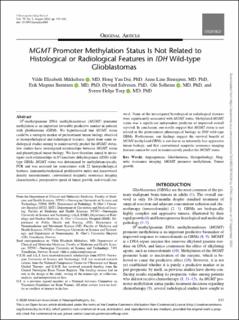| dc.contributor.author | Mikkelsen, Vilde Elisabeth | |
| dc.contributor.author | Hong, Yan Dai | |
| dc.contributor.author | Stensjøen, Anne Line | |
| dc.contributor.author | Berntsen, Erik Magnus | |
| dc.contributor.author | Salvesen, Øyvind | |
| dc.contributor.author | Solheim, Ole | |
| dc.contributor.author | Torp, Sverre Helge | |
| dc.date.accessioned | 2020-09-08T06:22:59Z | |
| dc.date.available | 2020-09-08T06:22:59Z | |
| dc.date.created | 2020-08-10T07:59:28Z | |
| dc.date.issued | 2020 | |
| dc.identifier.citation | Journal of Neuropathology and Experimental Neurology. 2020, 79 (8), 855-862. | en_US |
| dc.identifier.issn | 0022-3069 | |
| dc.identifier.uri | https://hdl.handle.net/11250/2676750 | |
| dc.description.abstract | O6-methylguanine DNA methyltransferase (MGMT) promoter methylation is an important favorable predictive marker in patients with glioblastoma (GBM). We hypothesized that MGMT status could be a surrogate marker of pretreatment tumor biology observed as histopathological and radiological features. Apart from some radiological studies aiming to noninvasively predict the MGMT status, few studies have investigated relationships between MGMT status and phenotypical tumor biology. We have therefore aimed to investigate such relationships in 85 isocitrate dehydrogenase (IDH) wild-type GBMs. MGMT status was determined by methylation-specific PCR and was assessed for associations with 22 histopathological features, immunohistochemical proliferative index and microvessel density measurements, conventional magnetic resonance imaging characteristics, preoperative speed of tumor growth, and overall survival. None of the investigated histological or radiological features were significantly associated with MGMT status. Methylated MGMT status was a significant independent predictor of improved overall survival. In conclusion, our results suggest that MGMT status is not related to the pretreatment phenotypical biology in IDH wild-type GBMs. Furthermore, our findings suggest the survival benefit of MGMT methylated GBMs is not due to an inherently less aggressive tumor biology, and that conventional magnetic resonance imaging features cannot be used to noninvasively predict the MGMT status. | en_US |
| dc.language.iso | eng | en_US |
| dc.publisher | Oxford University Press (OUP) | en_US |
| dc.rights | Navngivelse-Ikkekommersiell 4.0 Internasjonal | * |
| dc.rights.uri | http://creativecommons.org/licenses/by-nc/4.0/deed.no | * |
| dc.title | MGMT Promoter Methylation Status Is Not Related to Histological or Radiological Features in IDH Wild-type Glioblastomas | en_US |
| dc.type | Peer reviewed | en_US |
| dc.type | Journal article | en_US |
| dc.description.version | publishedVersion | en_US |
| dc.source.pagenumber | 855-862 | en_US |
| dc.source.volume | 79 | en_US |
| dc.source.journal | Journal of Neuropathology and Experimental Neurology | en_US |
| dc.source.issue | 8 | en_US |
| dc.identifier.doi | 10.1093/jnen/nlaa060 | |
| dc.identifier.cristin | 1822301 | |
| dc.description.localcode | VC 2020 American Association of Neuropathologists, Inc. 855 This is an Open Access article distributed under the terms of the Creative Commons Attribution Non-Commercial License (http://creativecommons. org/licenses/by-nc/4.0/), which permits non-commercial re-use, distribution, and reproduction in any medium, provided the original work is properly cited. For commercial re-use, please contact journals.permissions@oup.com | en_US |
| cristin.ispublished | true | |
| cristin.fulltext | original | |
| cristin.qualitycode | 2 | |

